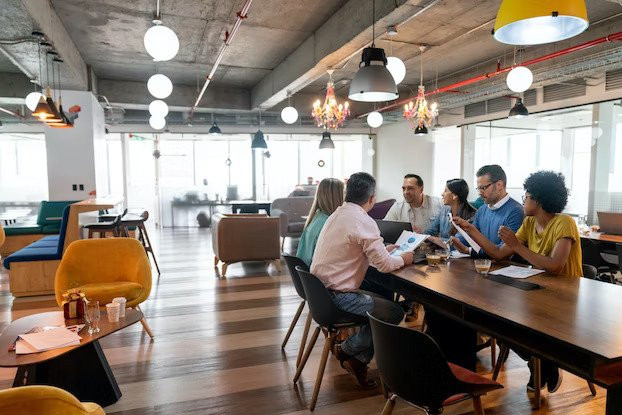More businesses are increasing days in the office - is remote work dying?
Mandating an increase in days in the office does not address why staff are reluctant to return, warns global workplace creation expert Unispace.

Mandating an increase in days in the office does not address why staff are reluctant to return, warns global workplace creation expert Unispace.
In the past few months, major companies such as KPMG, Starbucks and Twitter have ordered a return to in-person work.
However, Unispace has warned that this approach will be detrimental to employer brands and culture, as well as staff productivity, motivation and creativity.
"Business leaders have an understandable desire to encourage staff back to the office, but doing so without first addressing what is preventing employees from wanting to return of their own accord is a risky move," according to Lawrence Mohiuddine, CEO of EMEA at Unispace.
Before the Covid-19 pandemic, remote and hybrid working had been increasing gradually.
Between January and December 2019, around 12 per cent of the UK workforce had worked at least one day from home in the previous week and around 25 per cent reported working mainly from home.
However, as a result of the pandemic, and the subsequent lockdowns aimed at reducing the spread of the virus, the way in which people worked completely changed.
Data from the Office for National Statistics (ONS) shows that during the first lockdown, the number of adults working from home rose to almost 50 per cent.
As pandemic restrictions have been lifted, these numbers have gradually decreased again, but remain higher than pre-pandemic numbers.
In September 2022, 22 per cent of Great Britain's workforce had worked at least one day from home in the previous week and around 13 per cent worked from home exclusively.
Now, ONS suggests that Londoners have the highest levels of hybrid working than anywhere else in Great Britain, with four in 10 balancing working from home with commuting to work.
Data from a 2021 and 2022 survey estimated that more than 80 per cent of employees who worked from home because of the pandemic prefer a hybrid working model.
Benefits of flexible working can include increased well-being and self-reported productivity and work satisfaction. However, although businesses initially encouraged the hybrid model, many are now struggling with its challenges.
As a result of decreased in-office hours, many organisations face difficulties in staff interaction, collaboration, engagement and connection, as well as some negative impacts on working culture and productivity losses.
This has created a mismatch in the preference of employers and employees, which is a problem exacerbated by the current financial situation.
Last month, the Bank of England increased interest rates for the 11th time in a row. And as more economic uncertainty looms, and companies axe jobs on a wide scale, employers may use the downturn to enforce or overhaul their working practices.
"This is a dangerous approach," says Mohiuddine. She believes that instead, changes are needed in the workspace itself to better accommodate the new world of work.

According to a Unispace study of 3,000 office workers across Europe, staff want to see improvements in the working environment, with 95 per cent of those surveyed indicating a desire to make various physical changes to their office.
These included creating areas for private work, adding more amenities, improving the overall layout and adding more outdoor space.
The data suggests that office spaces are insufficient to support mental well-being in today's hybrid working environment.
"The fact that almost half of the workforce felt that their mental health improved while working from home, highlights that too many workplaces do not meet the needs of the people that use them," added Claire Shepherd, Chief Operating Officer at the Workspace firm.
The ability to work from home has changed the perception of what people want in their workplace.
Prior to the pandemic, the traditional workplace was accepted as it was. Now, many employees believe that certain tasks are most easily completed in a home environment.
For example, having spent so long instantly enabled from home to have private or sensitive conversations with clients and peers, now trying to handle these in an open-plan workspace will only lead to large meeting rooms being clogged up by individuals running a one-to-one phone or video call.
Mohiuddine warns that if these issues are not addressed, businesses could risk an exodus of talent unhappy with the set-up they are being forced into.
Aware that employees may be unhappy with the changes, some firms have veered away from calling the changes a "return to office", instead branding them as a move towards "flexible, intentional working".
However, some firms now believe the benefits outweigh the risks. They are willing to spend more time and resources getting employees back in the workplace more regularly - or find new ones that will.
"It shows how much they value that in-person interaction and leadership style," says Bryan Hancock, partner at McKinsey, a global management firm based in Washington, DC. "In a sense, they've seen that some elements have been lost during Covid, and this is a way of getting some of that back."
According to new research from the smarter job search engine Adzuna, the proportion of roles specifying they are 'office-based' has risen to a 19-month high of 4.2 per cent. Clearly, employers have become firmer on mandatory return-to-office policies
Google recently announced that it expects a norm going forward for people to typically work from the office about three days a week, with the remaining two days completed from home.
© Copyright IBTimes 2025. All rights reserved.






















